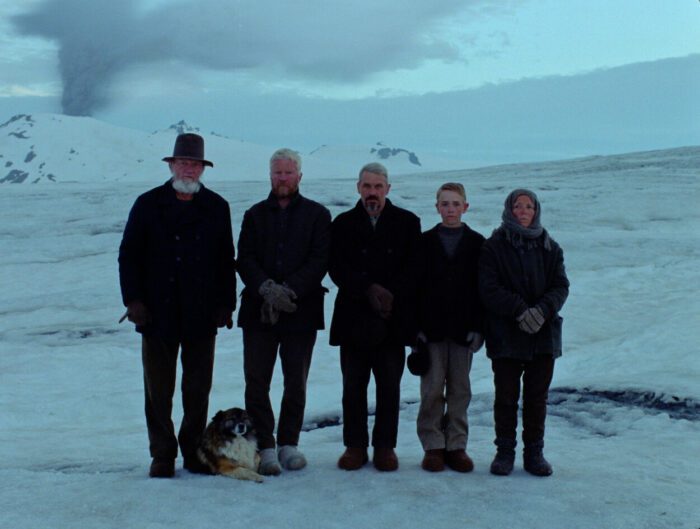Godland, the third feature film from Icelandic director Hlynur Pálmason, has been the subject of excited discussion and glowing reviews from film critics in recent weeks, and I’m pleased to report that it’s with very good reason. A calm, measured meditation on human hubris, resentment and bitterness, a fear of God and the difficulties of a soul undergoing a crisis of faith, Godland is an astonishing feat of filmmaking, its simplicity of technique and vaguely dreamlike quality staying with the viewer long after the final reel has finished rolling.
Godland focuses on Danish priest Lucas, played with wonderful attention to nuance by Elliott Crosset Hove, who in the 18th Century is sent to Iceland, then under Danish control, to supervise the building of a church in a remote region of the country and to remain there as the parish priest. Unfortunately for Lukas, his inability to connect with or display any empathy for the natives who are to be his flock leads to feuds with both his earthy, tough-as-leather guide Ragnar and with Carl, the head of the settlement where the church is located. Each of these feuds will end with terrible consequences.
Lucas is a strangely curious, neurotic mess of a man; a character study that would suit the likes of Dostoyevsky, and yet Lucas does not seem to have the self-awareness of a Raskolnikov. It is, in fact, unclear the extent to which Lucas understands the damage such isolation is causing him.
In itself, isolation could be considered an occupational hazard. As a priest, you essentially give your life over to God, to be his servant. As Lucas tells Ragnar, when Ragnar asks how to become a man of God, “you have to give yourself (to God) and follow his words. Pray to him. Listen…it’s not just about hearing. It’s more of a feeling. You must forget yourself and submit to God by serving him.”
Lucas, however, doesn’t seem particularly interested in doing the Lord’s good work, forgetting himself or giving himself to anyone other than those whose human flesh he covets. It is implied he has sex with Carl’s oldest daughter Anna. Then there is Lucas’s translator, who dies early on in the film, sharing a moment in a waterfall privately with Lucas which, while not explicit, seems to have homoerotic undertones, something which gives a little more depth than simple guilt when Lucas stares glumly at the translator’s photo later in the film.
Outside of the flesh, Lucas does not seem to love his fellow man very much. His only seemingly sincere prayer to God is to ask his Lord, when his journey is at its roughest, to take him far away from the unforgiving landscape and its people. He constantly looks down his nose at his guides and in particular, he develops a feud with the chief guide Ragnar, an older, earthier man whose initial dislike of Lukas is based on the priest’s lack of worldliness but soon develops into bitter hatred at the priest’s barely concealed contempt for men. Indeed, Lukas refuses to really learn the Icelandic language, even after the death of his translator, and dismisses Ragnar’s attempts to communicate in a tone that suggests it is Ragnar’s idiotic fault for even trying. In his mind, the priest has nothing to say to Ragnar that will not lower Lukas in the process.
Ironically, despite Ragnar’s disgust with Lukas, he does attempt to communicate with him. Ragnar understands the role of the priest is to serve God by serving man and offering spiritual support, something Lukas, due to his contempt for his fellow settlers, cannot offer. When Ragnar asks Lukas how to be a Man of God, Lukas uses Ida to translate and irritably and bluntly gives a stock answer in the hope Ragnar will be satisfied quickly and leave him be. But Ragnar is not the idiot Lukas believes him to be. He understands that even priests, God’s representatives on Earth, are mere mortal men who are also to be judged in the final balance. As he tells Lukas, “When I was a child, my mother told me that the King of Denmark was just an ordinary man. She told me that I would grow and that one day I would become a man. Therefore, I always thought that I would be the King of Denmark.” Strip away the privilege and position and we are all the same—ordinary people of flesh and blood.
The scene is set, then, for a confrontational climax which perhaps feels inevitable and yet still offers surprises and a touching close when the film’s entire philosophy is summed in a wonderfully concise, beautifully poetic phrase. You come away viewing the film as the characters within it view the landscape: fearful of its harsh reality and yet in awe of its severe beauty.

While the acting of Elliott Crosset Hove, Ingvar Eggert Sigurðsson and Ída Mekkín Hlynsdóttir amongst others is exceptional, the real star of Godland is its cinematography and editing. Everything, from the painterly-like framing of the forbidding yet beautiful Icelandic landscape to the minimalism of cuts to allow the film to breathe and flow tranquilly, all work together to form a hypnotic whole that allows the film to wash over the audience and pins them right into the film’s mood and environment.
Although it wouldn’t be strictly correct to catalogue Godland as an example of the Slow Cinema sub-genre, it shares enough with the form to bring it to mind, particularly earlier pioneers of Slow Cinema such as Tarkovsky. In Godland, the editing works to slow down the audience’s reading of what is in front of them, using regular static shots and measured, purposeful pans to focus the audience on the details and really take them in, such as the long pan in a circle round the wedding party partway through the film. The unhurried, continuous exposure to the actions and relationships of the guests satisfyingly immerses the viewer into the film’s world and establishes the power relations within the settler community.

Strikingly, Godland uses Lucas’s obsession with photography as a framing device for both the narrative and the cinematography. A caption heads the film, announcing:
A box was found in Iceland with seven wet plate photographs taken by a Danish priest. These images are the first photographs of the southeast coast. This film is inspired by these photographs.
Curiously, this a fictional device—no photographs of the sort have ever been found. Rather, director Pálmason used this idea as a way of creatively framing the world and aesthetic he was creating. The cinematography doubles down on this, using an aspect ratio (1.33:1) that puts the image in the centre of the screen and trims it into a square—much like a photograph. Once you’re aware of this, it creates a delicious frisson in your viewing experience, reflecting as it does Lucas’s perception of his surrounding—people included—as subjects to be photographed and catalogued. That the film will display, through its photographic frame, the real reality of Lukas’s world and the people he is enraging and refusing to engage with is the film’s great irony and a comment on the ill consequences of isolating oneself from the community—especially if that isolation comes from a place of misguided superiority.
Ultimately, Godland argues for a different kind of life, a faith in people and perhaps a heaven here on Earth, one that binds people together and to the environment. It’s a Sermon that passionately succeeds.



